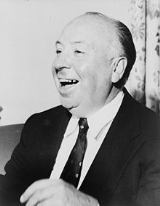
(13 August 1899 – 29 April 1980) was a British film director and producer. He pioneered many techniques in the suspense
and psychological thriller
genres. After a successful career in British cinema
in both silent film
s and early talkies
, Hitchcock moved to Hollywood
. In 1956 he became an American citizen, whilst remaining a British subject.
Over a career spanning more than half a century, Hitchcock fashioned for himself a distinctive and recognisable directorial style.
Never turn your back on a friend.![]()
I am a typed director. If I made Cinderella|Cinderella, the audience would immediately be looking for a body in the coach. ![]()
Television has done much for psychiatry by spreading information about it, as well as contributing to the need for it. ![]()
I’m frightened of eggs, worse than frightened, they revolt me. That white round thing without any holes … have you ever seen anything more revolting than an egg yolk breaking and spilling its yellow liquid? Blood is jolly, red. But egg yolk is yellow, revolting. I’ve never tasted it.![]()
One of television’s great contributions is that it brought murder back into the home, where it belongs.![]()
Seeing a murder on television can … help work off one’s antagonisms. And if you haven’t any antagonisms, the commercials will give you some.![]()
Dialogue should simply be a sound among other sounds, just something that comes out of the mouths of people whose eyes tell the story in visual terms.![]()
Give them pleasure — the same pleasure they have when they wake up from a nightmare.![]()

